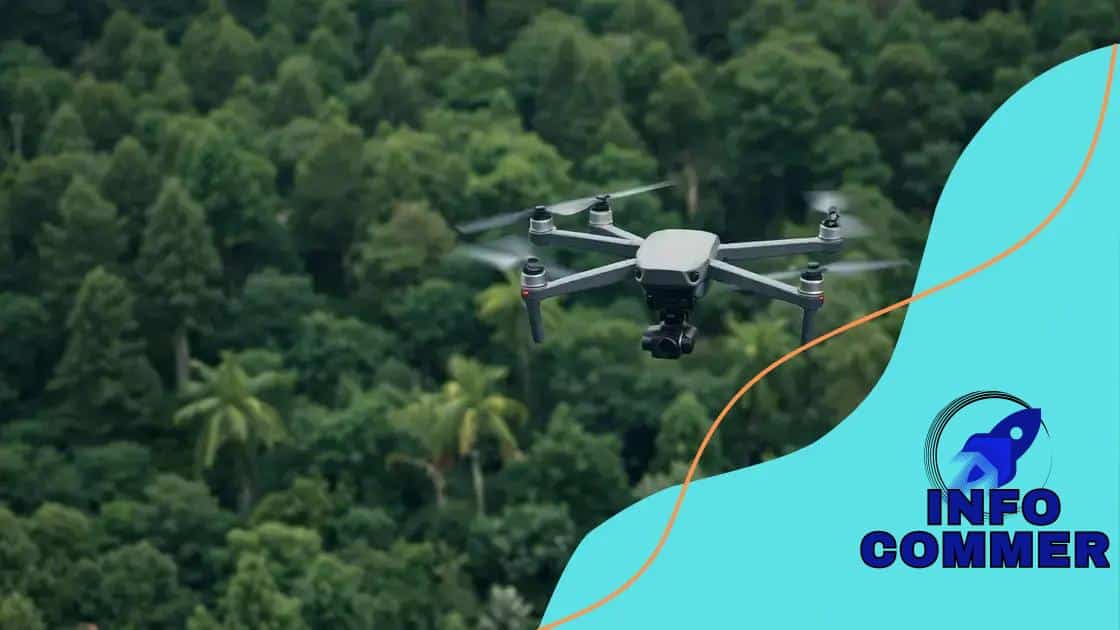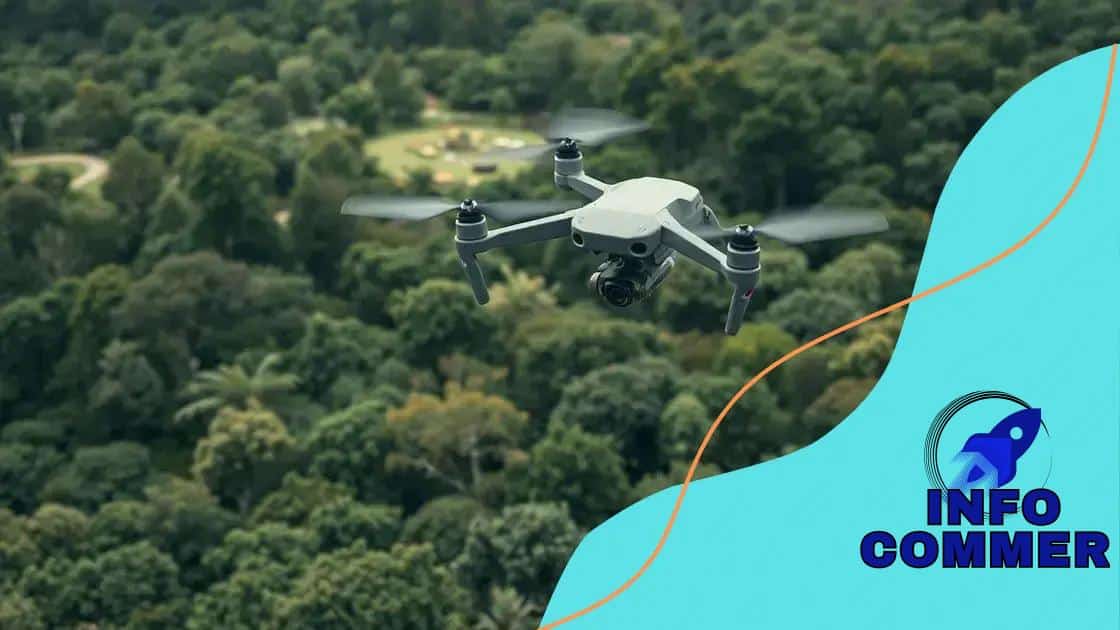Drones in conservation and environmental protection

Drones in conservation and environmental protection enhance wildlife monitoring, facilitate habitat restoration, and leverage advanced technologies to address environmental challenges effectively.
Drones in conservation and environmental protection are making waves in how we monitor ecosystems and their health. Imagine having the ability to survey vast areas with ease and precision. Ready to learn how they’re changing the game?
Applications of drones in wildlife monitoring
Drones have revolutionized wildlife monitoring by offering innovative solutions to researchers and conservationists. With their ability to cover large areas quickly and efficiently, these flying devices are changing how we observe and track wildlife populations. They provide a safe and non-intrusive way to gather invaluable data.
Real-time Data Collection
One of the most significant benefits of using drones is their capacity for real-time data collection. This technology allows researchers to monitor animal movements, behaviors, and even populations without disturbing their natural habitats. Imagine tracking an entire herd of elephants from the sky without causing them stress.
- Drones can detect unusual changes in wildlife behavior.
- They help in identifying migration patterns.
- High-resolution images provide insights into animal health.
- They can survey hard-to-reach areas efficiently.
Additionally, drones equipped with thermal imaging cameras can detect animals even in dense foliage, making their applications in wildlife monitoring even more critical. This technology aids in anti-poaching efforts by allowing for surveillance over vast terrains, ensuring the protection of endangered species.
Habitat Surveillance
Moreover, drones are not only beneficial for monitoring individual animals; they are also supportive in observing entire ecosystems. By using drones, scientists can assess habitat changes due to environmental factors, such as climate change or human activity. This insight helps in conservation planning and habitat restoration.
As technology advances, the potential for drones in wildlife monitoring continues to grow. New sensors and cameras enhance their functionality, making them indispensable tools for ecologists. Overall, the integration of drones into wildlife studies signifies a significant leap toward better conservation outcomes.
How drones aid in habitat restoration
Drones play a vital role in habitat restoration, making it easier for conservationists to restore ecosystems and promote biodiversity. With their precision and efficiency, these technologies change the way we approach environmental recovery.
Mapping and Assessment
Before any restoration efforts can begin, it is crucial to assess the current state of the habitat. Drones equipped with advanced imaging technology can create detailed maps of the area, identifying damaged regions and areas needing attention. This data helps conservationists prioritize their efforts more effectively.
- Drones can provide high-resolution aerial images for detailed assessment.
- They help in monitoring changes over time.
- Using GPS technology, drones can record specific locations of interest.
- They can survey large areas quickly, providing comprehensive data rapidly.
With this information, teams can develop targeted restoration plans to address specific problems. By understanding the landscape and its needs, we can restore habitats more effectively.
Planting and Reforestation
Another significant advantage of using drones is in the actual restoration process. Some drones are designed to perform seed bombing, which means they can distribute seeds over large areas efficiently. This method is especially effective in hard-to-reach regions. It allows for the planting of native species, which are crucial for restoring local ecosystems.
Moreover, drones can monitor these newly planted areas, ensuring that the seeds are germinating and healthy. By keeping tabs on the growth of the plants, conservationists can make necessary adjustments to improve the chances of success.
In conclusion, the integration of drones into habitat restoration provides innovative solutions that significantly enhance the effectiveness of conservation efforts. By combining technology with ecological knowledge, we can create a healthier planet for future generations.
Benefits of drone technology in environmental studies

The use of drones in environmental studies offers numerous advantages that enhance our ability to understand and protect our planet. These benefits transform traditional research methods, making them more efficient and effective.
Cost-Effectiveness
One key benefit of drone technology is its cost-effectiveness. Traditional methods, like manned aircraft or ground surveys, can be expensive and time-consuming. Drones provide a budget-friendly alternative that can cover large areas in a fraction of the time and cost.
- Reduced operational costs compared to traditional methods.
- Lower manpower requirements for data collection.
- Ability to gather data frequently, leading to timely insights.
This cost efficiency enables researchers and agencies with limited budgets to carry out essential studies without compromising quality.
Precision and Accuracy
Drones are equipped with advanced sensors and cameras that provide high-resolution images and data. This technology ensures precise measurements and observations, allowing scientists to obtain more reliable results. They can capture detailed changes in landscapes over time, which is crucial for monitoring environmental health.
Drones can also operate in challenging terrains, where traditional methods may fall short. This capability opens up vast areas for research that were previously inaccessible.
In addition to these technical advantages, drones facilitate collaboration among scientists. Researchers can share real-time data and visuals, enhancing communication and decision-making in conservation efforts. This teamwork is vital in addressing complex environmental issues.
With drones leading the way in environmental studies, we are better equipped to understand our ecosystems and respond effectively to challenges. By leveraging their benefits, we take significant strides toward a sustainable future.
Challenges faced by drones in conservation efforts
Drones offer impressive capabilities in conservation, but they also face several challenges that can hinder their effectiveness. Understanding these issues is key to improving their use in protecting the environment.
Regulatory Restrictions
One major challenge is the regulatory framework surrounding drone usage. Many regions have strict rules about where and how drones can be operated. These regulations can limit the areas where conservationists can use drones, preventing them from accessing critical habitats.
- Licensing requirements can be complex and time-consuming.
- Restrictions in national parks or protected areas may apply.
- Flight altitude limits can restrict data collection capabilities.
These barriers can slow down conservation efforts and add extra layers of planning and permissions to projects.
Technical Limitations
Drones still have technical limitations that can affect their performance in conservation tasks. Battery life is often a concern, as many drones can only fly for limited periods before needing a recharge. This limitation can restrict how much ground they can cover in one trip.
Additionally, adverse weather conditions like strong winds or rain can hinder drone operation. They may struggle to capture high-quality data in such conditions, which is crucial for accurate assessments.
Despite these hurdles, the technology behind drones is advancing rapidly. New developments in battery life and sensor technology are improving their capabilities, making them more reliable tools in conservation.
Moreover, the integration of drones with other technologies, such as machine learning and AI, is opening up new possibilities for data analysis. This synergy could help conservationists overcome some of the current challenges they face. By addressing these obstacles, we can maximize the impact of drones in conservation efforts, leading to better outcomes for wildlife and ecosystems.
Future trends in drone usage for environmental protection
The future of drones in environmental protection looks promising as technology continues to advance. Innovative developments are set to enhance their effectiveness and broaden their applications.
Integration of AI and Machine Learning
One of the most significant trends is the integration of artificial intelligence (AI) and machine learning. These technologies can analyze drone-collected data more effectively, providing deeper insights into environmental conditions. AI can help identify patterns in wildlife behavior, track changes in ecosystems, and enhance predictive modeling.
- Automated data analysis reduces human error.
- Improved predictive models help in proactive conservation efforts.
- AI can enhance image recognition for wildlife monitoring.
This integration not only streamlines workflows but also empowers conservationists with actionable intelligence.
Improved Drones and Sensors
Another trend is the development of more advanced drones and sensors. Future drones will feature longer battery life, greater payload capacity, and improved navigational capabilities. New sensors will provide better data on soil quality, water health, and overall ecosystem vitality.
With these advancements, drones can cover larger areas more efficiently, making them essential for large-scale conservation projects.
Moreover, drones may become increasingly autonomous, allowing them to operate with minimal human intervention. This autonomy will enable constant monitoring of critical habitats without the need for constant oversight.
As new technologies continue to emerge, such as drone swarming, where multiple drones coordinate to cover vast areas, the possibilities for environmental protection are expanding. This capability will allow conservationists to gather comprehensive data sets that detail changing ecosystems in real-time.
Overall, the future of drone usage in environmental protection holds exciting prospects. With continued innovation and investment, drones will become indispensable tools in the fight to conserve our planet for generations to come.
FAQ – Frequently Asked Questions about Drones in Environmental Protection
How do drones assist in wildlife monitoring?
Drones provide real-time data collection and high-resolution imagery, allowing researchers to monitor wildlife populations and behaviors without disturbing their habitats.
What role do drones play in habitat restoration?
Drones are used for mapping damaged areas, conducting seed bombing, and monitoring the growth of newly planted areas, enhancing the efficiency of restoration efforts.
What are some challenges faced by drone technology in conservation?
Drones encounter regulatory restrictions, technical limitations like battery life, and weather conditions that can hinder their operation in conservation efforts.
What future trends can we expect in drone technology for environmental protection?
Future trends include the integration of AI for better data analysis, advancements in drone designs for longer flights, and increased autonomy for monitoring critical habitats.





